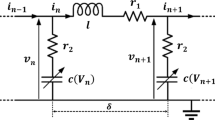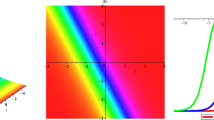Abstract
Based on the symmetry of the structure, a two-dimensional finite difference time domain (FDTD) method is used to analyze the sleeve monopole antenna on the infinite perfect conductor ground fed by a coaxial line. The fields in time domain are then turned into frequency domain through the discrete Fourier Transform to compute the surface current distribution and the input impedance of the sleeve monopole antenna. The gain or pattern of the monopole antenna is also computed, employing the combination of the image theory and the near-to-far transformation in frequency domain. All the computed results agree very well with the results of other methods and measured ones, verifying the application of the FDTD method to analyze the sleeve monopole antennas. The voltage standing wave ratio (VSWR) of the sleeve monopole antennas with different heights and radii of the sleeve are checked to study the influence of the sleeve, which indicates that the height and the radius of the sleeve are both important to the impedance bandwidth of the sleeve monopole antennas.
Similar content being viewed by others
References
Poggio A J, Mayes P E. Pattern Bandwidth Optimization of the Sleeve Monopole Antenna[J]. IEEE Trans Antennas Propagat Mag, 1966, 14(5): 643–645.
King R W P. Theory of Linear Antennas[M]. Harvard: Harvard University Press, 1956.
Taylor J. The Sleeve Antenna. Cruft Laboratory Technical Report 128[R]. Harvard: Harvard University, 1951.
Wunsch A D. Fourier Series Treatment of the Sleeve Monopole Antenna[J]. IEE Proc-H, 1988, 135(4): 217–225.
Shen Z X, Macphie R H. Rigorous Evaluation of the Input Impedance of a Sleeve Monopole by Modal-Expansion Method[J]. IEEE Trans Antennas Propagat Mag, 1996, 44(12): 1584–1591.
Sun Baohua. Efficient Computation of Sleeve Monopole Antennas[J]. Chinese Journal of Radio Science, 2000, 15(4): 517–521(Ch).
Guo Jingli, Liu Qizhong, Ji Yicai. Accurate Analysis of Sleeve Monopole Antennas Located at an Arbitrary Conducting Ground Plane[J]. Chinese Journal of Radio Science, 2004, 19(5): 613–617(Ch).
Guo Jingli, Liu Qizhong, Zhou Bin. Optimal Design of Sleeve Monopole Antennas Using Genetic Algorithm[J]. Journal of Microwaves, 2004, 20(1): 71–74(Ch).
Maloney J G, Smith G S, Scott Jr W R. Accurate Computation of the Radiation from Simple Antennas Using the Finite-Difference Time Domain Method[J]. IEEE Trans Antennas Propagat Mag, 1990, 38(7): 1059–1068.
Gedney S D. An Anisotropic Perfectly Matched Layer Absorbing Medium for the Truncation of FDTD Lattices[J]. IEEE Trans Antennas Propagat Mag, 1996, 44(12): 1630–1639.
Chew W C, Weedon W. A 3-D Perfectly Matched Medium from Modified Maxwell’s Equations with Stretched Coordinates[J]. Microwave Opt Technol Let, 1994, 7(13): 599–604.
Teixeira F L, Chew W C. systematic Derivation of Anisotropic PML Absorbing Media in Cylindrical and Spherical Coordinates[J]. IEEE Microwave Guided Wave Let, 1997, 7(11): 371–373.
Maloney J G, Shlager K L, Smith G S. A Simple FDTD Model for Transient Excitation of Antennas by Transmission Lines[J]. IEEE Trans Antennas Propagat Mag, 1994, 42(2): 289–292.
Douglas M, Okoniewski M, Stuchly M A. Accurate Modeling of Thin-Wire Antennas in the FDTD Method[J]. Microwave Opt Technol Let, 1999, 21(4): 261–265.
Author information
Authors and Affiliations
Corresponding author
Additional information
Foundation item: Supported by the National High Technology and Development Program of China(2001AA631050)
Biography: ZHANG Xiaolin(1981-), male, Ph. D. candidate, research direction: analysis and design of antennas, electromagnetic wave propagation.
Rights and permissions
About this article
Cite this article
Zhang, X., Gao, H. & Chen, C. FDTD analysis and application of sleeve monopole antenna. Wuhan Univ. J. of Nat. Sci. 12, 284–288 (2007). https://doi.org/10.1007/s11859-006-0013-5
Received:
Issue Date:
DOI: https://doi.org/10.1007/s11859-006-0013-5




